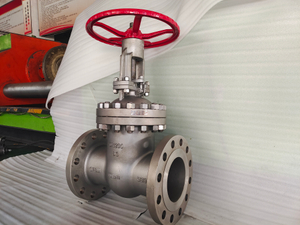As the core control equipment in industrial pipeline systems, the operation mode of gate valves directly affects production efficiency and safety. This article comprehensively compares the advantages and disadvantages of the three operation modes, namely manual, electric and pneumatic, from the dimensions of structural principles, performance indicators, application scenarios and future trends, so as to provide selection references for industrial users.
Read More
INTRODUCTION:
As a world-renowned valve manufacturer, J-VALVES has its WCB electric actuated flanged gate valves occupying an important position in the industrial field due to their excellent performance and reliability. This article will introduce in detail the technical parameters, performance characteristics, and application scope of these valves to help users better understand their advantages.

In industrial fluid control systems, the choice of valves has a crucial impact on the stability and cost-effectiveness of the system. TRUNNION BALL VALVES (meeting the MSS SP-72 standard) and traditional GATE VALVES are two common types of valves, and there are significant differences between them in terms of maintenance cycle, service life, and overall cost optimization.
Read More
Carbon steel gate valve, order from Swiss customer, the product is available in API600 design and EN 10434 design. The valve body is made of precision casting carbon steel material A216 WCB. The gate valve is the main product of J-VALVES company, and the annual sales volume of the product is about 1
Read More
As the core control equipment in industrial pipeline systems, the operation mode of gate valves directly affects production efficiency and safety. This article comprehensively compares the advantages and disadvantages of the three operation modes, namely manual, electric and pneumatic, from the dimensions of structural principles, performance indicators, application scenarios and future trends, so as to provide selection references for industrial users.
INTRODUCTION:
As a world-renowned valve manufacturer, J-VALVES has its WCB electric actuated flanged gate valves occupying an important position in the industrial field due to their excellent performance and reliability. This article will introduce in detail the technical parameters, performance characteristics, and application scope of these valves to help users better understand their advantages.
In industrial fluid control systems, the choice of valves has a crucial impact on the stability and cost-effectiveness of the system. TRUNNION BALL VALVES (meeting the MSS SP-72 standard) and traditional GATE VALVES are two common types of valves, and there are significant differences between them in terms of maintenance cycle, service life, and overall cost optimization.
Carbon steel gate valve, order from Swiss customer, the product is available in API600 design and EN 10434 design. The valve body is made of precision casting carbon steel material A216 WCB. The gate valve is the main product of J-VALVES company, and the annual sales volume of the product is about 1
Carbon steel gate valve, order from Swiss customer, the product is available in API600 design and EN 10434 design. The valve body is made of precision casting carbon steel material A216 WCB. The gate valve is the main product of J-VALVES company, and the annual sales volume of the product is about 1
In the field of industrial valves, flanged gate valves are widely used in industries such as petroleum, chemical engineering, and electric power due to their simple structure, good sealing performance, and low flow resistance. However, the standard systems in different countries and regions vary significantly, which requires users to understand and compare relevant standards when choosing products. This article will mainly analyze the technical requirements and performance differences of J-VALVES WCB electric actuated flanged gate valves under Chinese national standards (GB) and international standards (such as ISO, DIN, ANSI, etc.).
In industrial environments involving flammable and explosive media, the fire resistance performance of valves is of crucial importance. The ATEX standard is an authoritative standard used in Europe to evaluate the safety of equipment in potentially explosive environments and is widely applied in industries such as petroleum, natural gas, and chemical engineering. Ball valves and gate valves, as common types of industrial valves, have significant differences in their fire testing requirements under the ATEX standard.